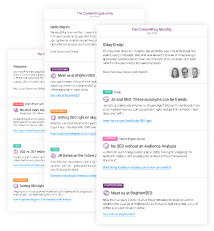When we get close to a content campaign, we stop seeing the flaws in it.
When we’ve had to pitch those ideas to bosses or clients, we become incredibly persuasive and convincing. In having written the pitch, you’ve not only convinced your client or boss to sign it off, but inadvertently further convinced yourself.
The joy of being human, eh?
Hi Stacey! Can you tell us a little about yourself?
Absolutely. I’m an SEO and content specialist. I worked for a Manchester agency for 9 years and then I set up on my own about 18 months ago. I now run my own agency, MacNaught Digital (opens in a new tab). There are 6 of us in the business now, we’re based way out of town in a lovely quiet area and we’re all hands on.
I speak regularly at events and have spoken at BrightonSEO, Mozcon, SearchLove, Learn Inbound and a number of others. I love getting out to conferences. Beyond the speakers, there’s so much value in just talking to other people who are facing the same challenges you are.
Why is most of the content out there shit?
Because… SEO!!
When you go back to the days of article spinning and systems like Unique Article Wizard that would let you create hundreds of (questionable) articles out of just 3 versions, it’s easy to see just how easy it is to pollute the internet with crap.
Articles like "The Benefits of Hiring an Accountant," or "The History of Kitchen Fitting," are titles I’ve seen in the wild over the years. Dull! And done purely to try and scale easy links.
More recently, the industry is shifting to better content. We see a lot less article spinning. But there’s still some awful infographics, reports and other types of content out there. And I think it’s down to a few things but three of the biggest:
- The pressure to scale: SEOs are always under pressure to build more links or gain more rankings. When there’s a pressure to scale constantly, quality can drop.
- A lack of validation: I’ve worked with so many companies whose creative teams never get any external validation on their ideas. When you get close to an idea, you stop seeing its flaws.
- Format first content: If a content piece starts with “let’s make an infographic,” then there’s a good chance it will be crap. Format last. Story first.
How can you turn this around, and actually create good content?
It’s all about the story. Great content is less about bells and whistles or graphics and more about the story at the centre of it.
I think the starting point for any piece of content is to ask:
- What’s my goal?
- Who’s the audience I want to reach?
- What do they care about?
Great content makes some sort of connection with human viewers - it resonates. So I think more focus on the story is the key thing.
Does the world really need more content?
Yes.
We’ve all read opinions to the contrary here - we’re told we’ve reached content saturation. But I disagree.
It’s like saying the world doesn’t need anymore new smartphones or games consoles. Or anymore news?
Yes, there’s more content out there now than ever before. But equally, we’re consuming more.
We need to be smarter about what sort of content. The world may not need more long form content about generic topics. But creative pieces, advice on new trends, stories that haven’t been told yet… I think there’s always space for more of that.
What do you do if you can’t get in your creative flow?
I go for a walk, or I do something completely different. I’m not a good contributor in a creative session at certain times of day or if I’m running on insufficient sleep. So I’ve worked out when I’m most useful in creative sessions and try to schedule them accordingly.
But if I’m really in a funk and just can’t get my head in the game, I try to get outside or I go play a game with my children or something.
When you stare at a problem and find no breakthrough, I find you just have to walk away for a bit and come back with fresh eyes.
In terms of days where the team as a whole is struggling with creativity, we try things like “Worst Ideas Method” (from Bryan Mattimore’s Idea Stormers (opens in a new tab)). We don’t use it in the exact way it’s described in the book. But we inject energy into brain storms by asking people to come up with crap ideas! People feel less intimidated by this request, so even those who struggle to speak up with ideas feel, we’ve found, more confident in sharing.
It gets laughs. It gets people talking and breaks the ice. And when there’s energy back in the room, we bring it back to the brief at hand. I love that as a means of putting energy in the room.
Can you do great content marketing, on a not-so-great budget?
Absolutely. It’s easy to think that more budget means better content but I find it often isn’t the case.
And actually, restricted budgets means you’re often forced to get more creative.
The success or failure of content marketing with a link building/coverage building objective comes down fundamentally to story (not bells and whistles). Stories aren’t easy to come up necessarily. But they’re not expensive.
When you’re budget restricted, put your time into planning, story and promotion and cut costs on design and development.
How important is content promotion to the success of a content marketing strategy?
Absolutely imperative. Unless you’re a major brand or publisher and have people just waiting for your content, then promotion is absolutely key.
Whether it’s paid promotion, outreach, email marketing… whatever it is, you need to do something proactive if you’re expecting eyes on what you’ve just made.
I think promotion should generally take longer than production and, unless the content is seasonal, it should be an ongoing thing. We can’t just be thinking about launching and then hoping for the best,
What’s your approach to effective content promotion?
It very much depends on the nature of the content. If I’m working, as I often am, with data led pieces, then an important job for me is to optimise the on site asset for “statistics,” related queries that we know people researching their own content will be sharing. Then I know we have longevity in the piece.
In terms of proactive placement, I source the most relevant journalists (manually) first for the piece and reach out to them before it is created to get their take on the initial idea and whether they’re likely to be interested. That helps to reformulate the final idea, or weed out weaknesses within it.
These tier one contacts are the first ones I reach out to when it’s ready too. I approach this very manually, relatively customised emails. Or if it’s people I’ve dealt with before, I might approach by social media message. There are writers I now deal with on Whatsapp at their request because it’s easier than sifting through busy inboxes.
After hitting tier ones, I create tier two lists that are generally bigger with a little less customisation. These might include local or regional press or very specific trade press depending on the nature of the campaign.
Again this is reasonably manual a process, but you can get some help finding email addresses through databases or Chrome plugins like ContactOut.
I’ve found paid promo for content can work too, particularly on the stats type content again. If someone is searching for “stress statistics” and you have a report all about it, then you want them to be finding you at the point they’re looking for a source. So if you’re not there organically yet, then pay to play - Google Ads!
How do you drive traffic and gain links in "boring" niches?
Boring niches are often not as boring as we think they are. Boring industries are normally considered so because the product or service is something people have to have rather than want to have. Examples life insurance, car insurance, washing machines…
Granted, on the surface it’s not as exotic as a travel campaign or a campaign for a retailer selling fashion that everybody seems to want right now!
But actually there’s a ton of opportunity in it. For a start, essential (non-desire) purchases often have extensive research processes. If people are buying something because they have to and not because they want to, there’s an opportunity to get in and create content around the trigger for them buying.
People buy washing machines because their old one broke a lot of the time. Or they buy life insurance because they just had children and now feel a responsibility to look out for their financial future.
So I focus more on ideas centred around the events and reasons why someone needs the product than on the product itself. That makes your content about real life things that happen to people - things that people care about.
How would you approach content marketing in a YMYL niche to be as Google update-proof as can be?
I actually don’t think much needs to change if you’ve been approaching content properly over the past few years anyway.
To me, it just means you’ve got more need to consider the “E-A-T,” elements of content. But in truth, I think most in the industry have been focussed on this (without calling it such) for years.
And I think we should be doing it as a matter of course whether our websites qualify as YMYL or not. Ultimately, I make sure that the content is accurate, that we’ve had input from someone qualified to write on that subject matter and that we’re taking every single step to make it trustworthy.
From a practical perspective of things you can do if you think you maybe haven’t been quite getting it right, take a look at Marie Haynes’ take on E-A-T (opens in a new tab) and her talk from SearchLove London on E-A-T (opens in a new tab) too.
What would be your number one tip to craft a great content marketing campaign?
Get outside input.
When we get close to a content campaign, we stop seeing the flaws in it. When we’ve had to pitch those ideas to bosses or clients, we become incredibly persuasive and convincing. In having written the pitch, you’ve not only convinced your client or boss to sign it off, but inadvertently further convinced yourself.
The joy of being human, eh?
What this means is that even if you start to see little flaws later in the process, then you’re likelier to “explain them away,” than to stop the campaign from progressing.
So I like to have outside input at multiple stages in the process, whether it’s from journalists, friends not involved or people from your target demographic you don’t know sourced through a survey company or something.
However you do it, validate ideas with people not already bought in at various parts of the process.



